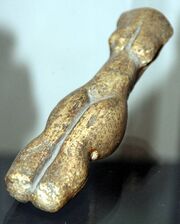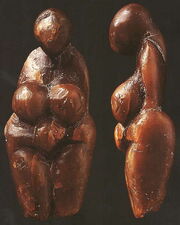Venus figurines are statuettes that portray a woman. Most have been unearthed in Europe, but others have been found as far away as Siberia, extending their distribution across much of Eurasia, although with many gaps, such as the Mediterranean outside Italy.[1][2]
Ivory types[]

The Yeliseevichi Venus carved from Ivory
A common material that many Venus figurines have been carved from is ivory, a hard, white material from animal tusks, such as mammoth, elephant, walrus, and narwhal. The following is a list of ivory Venus figurines:
- See also Wikipedia, Venus of Brassempouy
Soapstone types[]

Venus of Menton carved from Soapstone
Soapstone (also known as steatite or soaprock) is another common material that Venus figurines are crafted from. It is a metamorphic rock, largely composed of the mineral talc, rich in magnesium. The following is a list of soapstone Venus figurines:
- Hermaphrodite Venus
- Losange Venus
- Menton Venus
- Negroid Head
- Perforated Neck Venus
- Polichinelle Venus
- Undescribed Venus
References[]
- ↑ Fagan, Brian M., Beck, Charlotte, "Venus Figurines", The Oxford Companion to Archaeology, 1996, Oxford University Press, ISBN 0195076184, 9780195076189, google books p. 740-741
- ↑ Beck, Margaret, in Ratman, Alison E. (ed.), Reading the Body: Representations and Remains in the Archaeological Record, 2000, University of Pennsylvania Press, ISBN 0812217098, 9780812217094, google books, p. 203
Resources[]
- Pinterest, Venus figurines gallery
- Wikipedia, Venus figurines